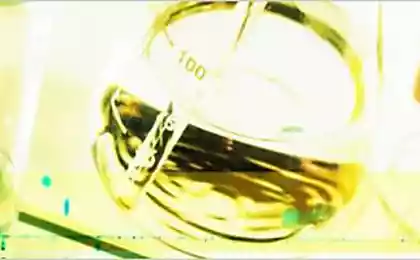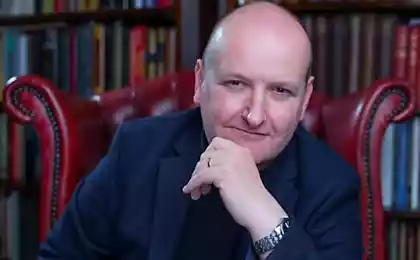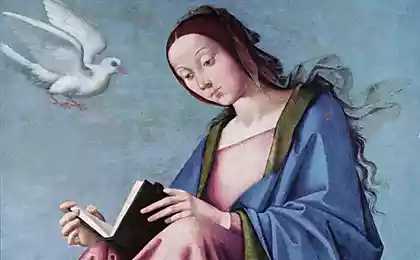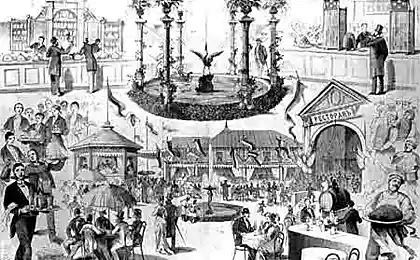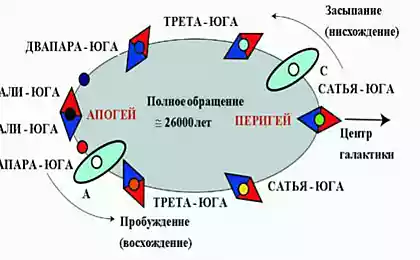515
Was the dark Middle ages
The Middle ages are often considered a dark stain on the pages of history, the realm of obscurantism — were burned at the stake witch, and the streets were dominated by fear and ugliness. The name itself emphasizes the impersonality of this age, which overshadow two adjacent: antiquity and the Renaissance, rich in aesthetic and cultural sense.
If you have ever turned to the texts created more than five centuries ago, you will agree that the events described therein, set forth not as we used to. Perhaps this is due to the fact that while the world was still presented to people in a wonderful robe of mystery, and European society still have not lost faith in the supernatural. Try to understand in what light brought life, when humanity and the world was younger:
The brightness and sharpness of lifeHuman feelings were expressed more directly. Soul couldn't hide his feelings, and the mind is not trying to suppress them. Joy and sorrow, laughter and tears, poverty and wealth were displayed publicly without constraint and fear. Ritual permeated every action or act, "elevating them to other extraterrestrial lifestyle".
As noted by one of the principal investigators of the era of Johan Huizinga, all aspects of life then flaunted.It concerned not only the most important events of human life (birth, marriage and death, reaching splendour of the mysteries), but social events: the solemn meeting of the king or punishment, which became not only a moral but also a colourful spectacle.

Of course, the life of medieval man was not pretty by itself. Living conditions without electricity, sewage and heating was far from being called perfect, but because the beauty it was necessary to create artificially.
The pursuit of the beautiful lifeIn the Middle ages, the aesthetic perception of the world preobladaet logical and ethical. Form of lifestyle transformed in the art, and the society became more and more gaming, to the extent that any action is turned into ritual.

The art of the Renaissance appeared in the history of the world nowhere. Culture at the end of the middle Ages — "the colorization of the aristocratic life of ideal forms of life occurring in the artificial light of chivalric romance, this is a world disguised in the outfits of king Arthur."
This artificial, aesthetic coverage of all the events created strong tension, shaping the thoughts and manners of the medieval man.Court life was permeated with aesthetic forms to the obscene, the diversity of colors here blinded citizens that proved and justified the power of the upper class. The dirty beggars, the merchants and villagers have seen the true proof of a noble origin in the beauty of the garments of the nobility and court decorations.
Formalization of life life on Earth, clothed in aesthetic forms, not only attracted attention, but also found a previously unknown to humanity dimension. Formalism in relations sometimes prevented the natural communication between people, however, gave them the greatest aesthetic pleasure, occupying an intermediate position between sincerity and etiquette.
There is something touching in that "perfect form" produced in the hard struggle of a generation of people passionate temper, and sometimes become a never-ending polite bickering. A visit to the temple turned into a sort of minuet — at the exit there was a competition for the provision of the person of higher rank before the others go through the bridge or through the narrow street. As soon as someone came to his house, he had — as yet still requires the Spanish custom is to invite all to come to his house to get a drink, an offer like everyone should politely refuse; then needed some to hold the rest, and all this, of course, was accompanied by mutual wrangling.
Loud suffering on display was considered not only appropriate but also beautiful, making daily life into a genuine dramatic art.
Pain takes on the rhythm of theFuneral rites were also accompanied by the celebration of suffering in which the mountain was clothed in a wonderful and even sublime form.
The reality has moved into the sphere of drama. In more primitive cultures, funeral rites and poetic funeral laments still form a coherent whole; mourning its splendor was intended to emphasize how upset affected with grief.
Such forms are easily lost real experience. Here is an excerpt from the notes Alienor de Poitiers about the widowed Isabella of Bourbon: "When Madame remained by itself, is not she stayed always in bed, in the same way as in the chambers". That suggests a conscious desire for the dramatic, the cause of which was public customs.
People liked everything that had to do with the sphere of the ethical, the aesthetic took shape.A special category of people to whom the townsfolk felt a genuine interest, were preachers and ascetics. Amazement at the humility and mortification of the saints of the ascetics before the penitential renunciation of sins reached the highest degree of admiration and admiration. Any personal experience, excitement and achievement was to find the necessary public form of expression, as enshrined in the culture.
Love and friendshipthere is a special form of friendship called minjustom — it lasted until the XVII century. Every self-respecting court had a close friend, habits, clothing and appearance is required must have repeated his own. The minions took out, walk, work. This friendship was purely aesthetic sense and was intended to dilute the loneliness and boredom, and add symmetry to life.
Courtesy and etiquette were directly related to the clothing, which had certain meanings.For example, if a girl was willing to declare allegiance to the beloved, wore clothes of blue color, while the clothes of green testified to the love.
In love for those who broke with all worldly pleasures in General, manifested the purpose and nature of pleasure as such. The feeling of love was appreciated much more than relationships, and especially marriage. It often happened that a young married woman remained a lady of many knights, who shouted out her name on the battlefield.
All beautiful — every single sound or a flower — graced love. Literature, fashion, customs has streamlined attitude to love, creating a beautiful illusion, for which people wanted to follow.

Love became a form of fantastic things. The tournament offered the game of love in the most heroic form. The winner getting a special gift in the form of a scarf or a kiss sweetheart.
Short circuitit is Important to understand that the medieval man lived in a completely different world than we are. His life was permeated with the divine mystery, and therefore any phenomenon regarded as a sign. He lived in the only semiotically saturated world. Full semantic references and the higher meanings of the manifestations of God in things; he lived in nature, which constantly spoke the language of heraldry.
The lion, the eagle, the serpent not only real animals but symbols, pointing the way to truth, which meant more than the objects themselves. Allegorism extended to all the phenomena of life and even served as a call-to-action.
Often, when the sound of rain enters into a trance, or lamp light is refracted in a certain way, we too can experience a different range of feelings, normally hidden in everyday life and Affairs.It gives us a sense of the infinite mysteries of the world and can make you a little happier to return to the state, which the medieval man had always.
Dark ages — the illumination of the revival of theBeauty of everyday life was considered sinful, so have purchased a double appeal, and if before it gave up, enjoyed passionately as ever.
In religious art-the plot to save the beauty from the printing sinfulness. If in the Middle ages in music and the visual arts saw sense, but only if they were part of the worship of Christ and outside the Church to study art was refused. Already the Renaissance, breaking the outdated idea of the pleasures of life as sinful, "seeks to enjoy life to the full".
The art is all life, and even the most unsightly forms are converted into higher evidence of beauty and admiration.In the era of New Time art begin to enjoy in isolation from life, it begins to rise above it, and life itself loses its aesthetic dimension. With this loss and the associated longing for the middle ages, the era in which the sky was higher and the grass is greener. published
Author: Kirill Dobronravov
Source: newtonew.com/discussions/medieval-sadness-and-happyness
If you have ever turned to the texts created more than five centuries ago, you will agree that the events described therein, set forth not as we used to. Perhaps this is due to the fact that while the world was still presented to people in a wonderful robe of mystery, and European society still have not lost faith in the supernatural. Try to understand in what light brought life, when humanity and the world was younger:
The brightness and sharpness of lifeHuman feelings were expressed more directly. Soul couldn't hide his feelings, and the mind is not trying to suppress them. Joy and sorrow, laughter and tears, poverty and wealth were displayed publicly without constraint and fear. Ritual permeated every action or act, "elevating them to other extraterrestrial lifestyle".
As noted by one of the principal investigators of the era of Johan Huizinga, all aspects of life then flaunted.It concerned not only the most important events of human life (birth, marriage and death, reaching splendour of the mysteries), but social events: the solemn meeting of the king or punishment, which became not only a moral but also a colourful spectacle.

Of course, the life of medieval man was not pretty by itself. Living conditions without electricity, sewage and heating was far from being called perfect, but because the beauty it was necessary to create artificially.
The pursuit of the beautiful lifeIn the Middle ages, the aesthetic perception of the world preobladaet logical and ethical. Form of lifestyle transformed in the art, and the society became more and more gaming, to the extent that any action is turned into ritual.

The art of the Renaissance appeared in the history of the world nowhere. Culture at the end of the middle Ages — "the colorization of the aristocratic life of ideal forms of life occurring in the artificial light of chivalric romance, this is a world disguised in the outfits of king Arthur."
This artificial, aesthetic coverage of all the events created strong tension, shaping the thoughts and manners of the medieval man.Court life was permeated with aesthetic forms to the obscene, the diversity of colors here blinded citizens that proved and justified the power of the upper class. The dirty beggars, the merchants and villagers have seen the true proof of a noble origin in the beauty of the garments of the nobility and court decorations.
Formalization of life life on Earth, clothed in aesthetic forms, not only attracted attention, but also found a previously unknown to humanity dimension. Formalism in relations sometimes prevented the natural communication between people, however, gave them the greatest aesthetic pleasure, occupying an intermediate position between sincerity and etiquette.
There is something touching in that "perfect form" produced in the hard struggle of a generation of people passionate temper, and sometimes become a never-ending polite bickering. A visit to the temple turned into a sort of minuet — at the exit there was a competition for the provision of the person of higher rank before the others go through the bridge or through the narrow street. As soon as someone came to his house, he had — as yet still requires the Spanish custom is to invite all to come to his house to get a drink, an offer like everyone should politely refuse; then needed some to hold the rest, and all this, of course, was accompanied by mutual wrangling.
Loud suffering on display was considered not only appropriate but also beautiful, making daily life into a genuine dramatic art.
Pain takes on the rhythm of theFuneral rites were also accompanied by the celebration of suffering in which the mountain was clothed in a wonderful and even sublime form.
The reality has moved into the sphere of drama. In more primitive cultures, funeral rites and poetic funeral laments still form a coherent whole; mourning its splendor was intended to emphasize how upset affected with grief.
Such forms are easily lost real experience. Here is an excerpt from the notes Alienor de Poitiers about the widowed Isabella of Bourbon: "When Madame remained by itself, is not she stayed always in bed, in the same way as in the chambers". That suggests a conscious desire for the dramatic, the cause of which was public customs.
People liked everything that had to do with the sphere of the ethical, the aesthetic took shape.A special category of people to whom the townsfolk felt a genuine interest, were preachers and ascetics. Amazement at the humility and mortification of the saints of the ascetics before the penitential renunciation of sins reached the highest degree of admiration and admiration. Any personal experience, excitement and achievement was to find the necessary public form of expression, as enshrined in the culture.
Love and friendshipthere is a special form of friendship called minjustom — it lasted until the XVII century. Every self-respecting court had a close friend, habits, clothing and appearance is required must have repeated his own. The minions took out, walk, work. This friendship was purely aesthetic sense and was intended to dilute the loneliness and boredom, and add symmetry to life.
Courtesy and etiquette were directly related to the clothing, which had certain meanings.For example, if a girl was willing to declare allegiance to the beloved, wore clothes of blue color, while the clothes of green testified to the love.
In love for those who broke with all worldly pleasures in General, manifested the purpose and nature of pleasure as such. The feeling of love was appreciated much more than relationships, and especially marriage. It often happened that a young married woman remained a lady of many knights, who shouted out her name on the battlefield.
All beautiful — every single sound or a flower — graced love. Literature, fashion, customs has streamlined attitude to love, creating a beautiful illusion, for which people wanted to follow.

Love became a form of fantastic things. The tournament offered the game of love in the most heroic form. The winner getting a special gift in the form of a scarf or a kiss sweetheart.
Short circuitit is Important to understand that the medieval man lived in a completely different world than we are. His life was permeated with the divine mystery, and therefore any phenomenon regarded as a sign. He lived in the only semiotically saturated world. Full semantic references and the higher meanings of the manifestations of God in things; he lived in nature, which constantly spoke the language of heraldry.
The lion, the eagle, the serpent not only real animals but symbols, pointing the way to truth, which meant more than the objects themselves. Allegorism extended to all the phenomena of life and even served as a call-to-action.
Often, when the sound of rain enters into a trance, or lamp light is refracted in a certain way, we too can experience a different range of feelings, normally hidden in everyday life and Affairs.It gives us a sense of the infinite mysteries of the world and can make you a little happier to return to the state, which the medieval man had always.
Dark ages — the illumination of the revival of theBeauty of everyday life was considered sinful, so have purchased a double appeal, and if before it gave up, enjoyed passionately as ever.
In religious art-the plot to save the beauty from the printing sinfulness. If in the Middle ages in music and the visual arts saw sense, but only if they were part of the worship of Christ and outside the Church to study art was refused. Already the Renaissance, breaking the outdated idea of the pleasures of life as sinful, "seeks to enjoy life to the full".
The art is all life, and even the most unsightly forms are converted into higher evidence of beauty and admiration.In the era of New Time art begin to enjoy in isolation from life, it begins to rise above it, and life itself loses its aesthetic dimension. With this loss and the associated longing for the middle ages, the era in which the sky was higher and the grass is greener. published
Author: Kirill Dobronravov
Source: newtonew.com/discussions/medieval-sadness-and-happyness
How to create the grapes in the form of a fan without the trunk
Don't make the mistake of punishing the child
